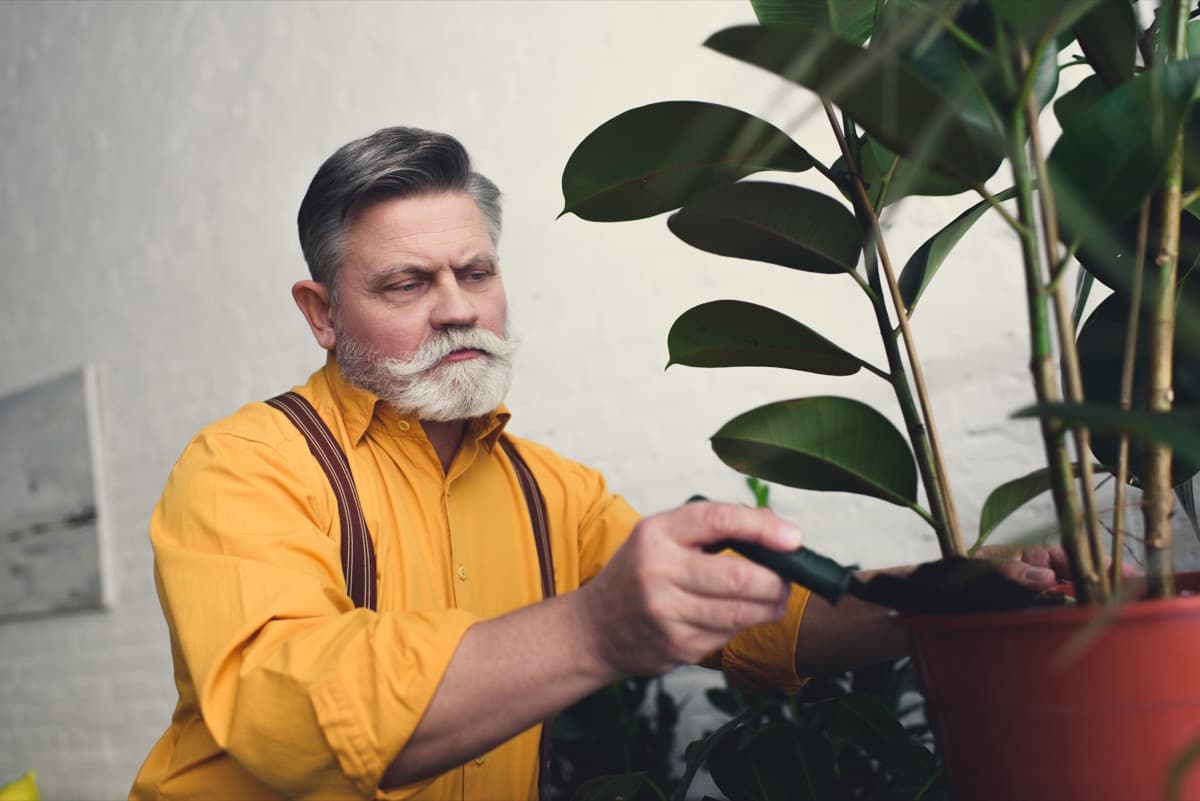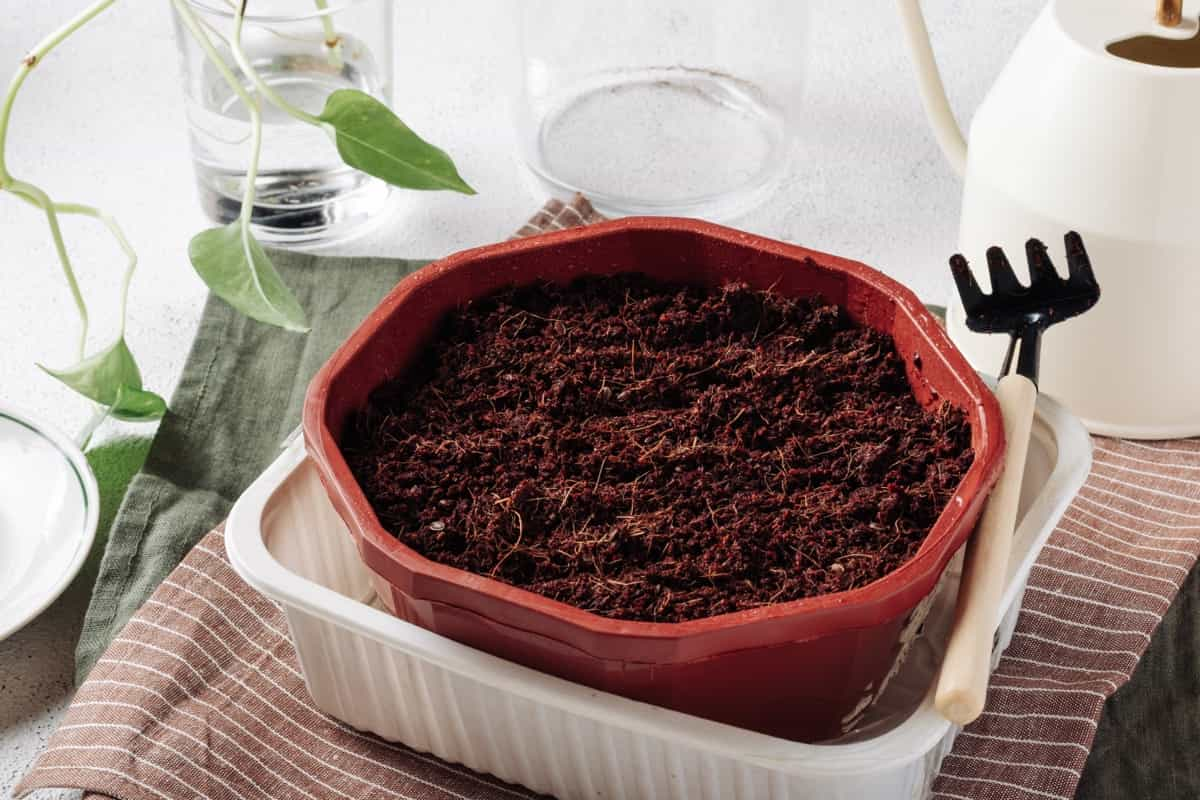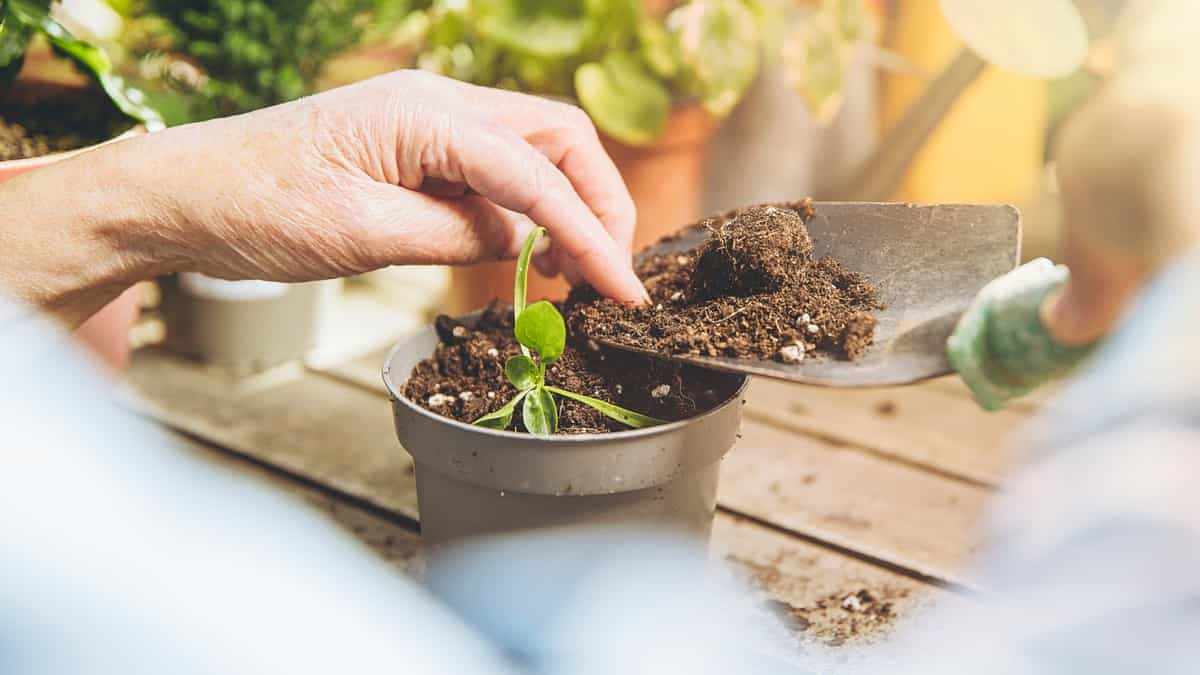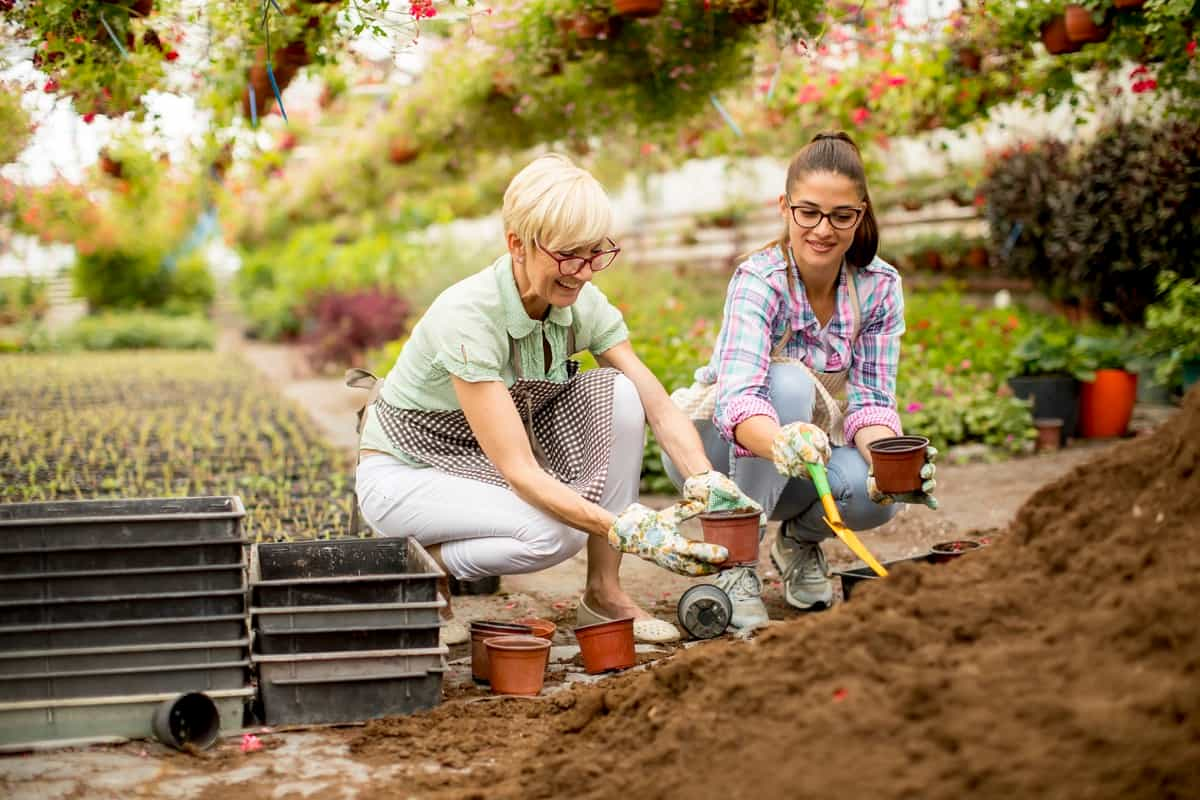The soil is the most important aspect of growing plants. It is the foundation that provides support and necessary nutrients to the plant. The soil’s physical structure allows for aeration, water retention, and drainage, while the chemical makeup provides essential nutrients for plant growth. Let’s check out the best ways to rejuvenate old potting soil below.

The biology of soil includes beneficial microorganisms that help to break down organic matter and make nutrients available to plants. Regarding gardening, few things are more important than healthy potting soil. But over time, even the best potting soil can become depleted of nutrients and unable to support robust plant growth. If you grow plants in containers, you know that potting soil can deteriorate quickly.
Every time you water, some nutrients are leached out of the soil and into the water. Additionally, as the organic matter in the soil breaks down, it becomes less able to hold water and air. This leads to compaction, which makes it difficult for plant roots to penetrate and results in dry, stunted growth. Potting soil is not an infinite resource. Every time you use it, some of its nutrients are depleted, and it becomes less effective at supporting plant growth. This is why it’s important to rejuvenate old potting soil regularly.
Best Ways to Rejuvenate Old Potting Soil
Sterilizing
Sterilizing potting soil is important if you want to reuse it or are concerned about bringing pests or diseases into your home. There are a few ways to sterilize potting soil, and the best method for you will depend on how much soil you have and what equipment you have available. One way to sterilize potting soil is to bake it in the oven. This method works well for small amounts of soil, and it will kill any pests or diseases that may be present.
In case you missed it: How to Prevent Soil Compaction in Pots: Tips to Loosen the Hardened Potting Soil

To bake your soil, spread it in an oven-safe dish and bake at 94°C for 30 minutes. Allow the soil to cool completely before using it. Another way to sterilize potting soil is to soak it in boiling water. This method is effective for larger soil but requires more time and effort. Place your soil in a large container and add enough boiling water to cover it.
Let the soil soak for at least an hour, then drain and allow it to cool completely before using it. Finally, you can try solarization. This involves covering the soil with clear plastic for several weeks, which heats the soil and kills off pathogens and weed seeds. No matter your chosen method, sterilize your potting soil before using it again or bringing it into your home. This will help your plants stay healthy and free from pests or diseases.
Test the Soil pH
If your potting soil is old and tired, rejuvenate it and make it all powerful again with a few simple steps. One important step is to perform a soil pH test. This will tell you the acidity or alkalinity of your soil, which is important to know to care for your plants properly. Once you know the pH of your potting soil, you can make any necessary adjustments.
If you have too acidic soil, you may need to add some lime to raise the pH. Conversely, if the soil is too alkaline, you may need to add some sulfur to lower the pH. These simple adjustments can go a long way in rejuvenating old potting soil and making it all-powerful again.
In case you missed it: Plants That Grow Well in Acidic Soil: Every Gardener Should Know These

Restoring
There’s nothing quite like potting soil that’s been used and abused to give your plants a good home. But, after a while, it can become depleted of nutrients and lose its ability to hold water. If you’re not ready to toss it out and start fresh, there are ways to rejuvenate old potting soil and make it all powerful again. Remove any dead plants or debris from the soil.
This will help improve drainage and aeration. Add some fresh organic matter to the soil. This could include compost, manure, or leaf mold. Water deeply and regularly. This will help promote healthy root growth. Apply mulch to the soil surface. This will help maintain moisture content and keep weeds at bay. Feed your plants with a high-quality fertilizer. This will give them the nutrients they need to thrive.
Remove Excess Salts from the Potting Soil
If you’ve been using the same potting soil for a while, it’s likely to become full of excess salts. Over time, these minerals can build up in the soil, making it difficult for plants to absorb moisture and nutrients. To remove excess salts from your potting soil, you’ll need to flush them out with fresh water. Add enough water to the potting mix to saturate it, then drain it for a few hours. Repeat this process several times until the water that drains out is clear. This will help leach out any excess salts accumulated in the soil.
In case you missed it: Soil Borne Diseases and How to Treat Them Effectively: Control and Prevention Methods

Add Organic Matter
As your potting soil ages, it becomes depleted of nutrients and organic matter. Adding new organic matter is the best way to rejuvenate old potting soil and make it all powerful again. There are a few ways to add fresh organic matter to your potting soil. If you’re adding it from your garden bed, add a 2-3 inches layer and mix it well. One way to do this is to amend the soil with fresh compost or other organic matter. This will help replenish nutrients that have been lost over time. You can also add some sand to improve drainage if the soil has become compacted.
You can make your potting mix from scratch. This DIY mix includes peat moss, perlite, vermiculite, and composted manure. It’s a little more work than simply amending existing soil, but it will be worth it when your plants thrive once you’ve added fresh organic matter to your potting soil and water and mixed it well. Your old potting soil will now be rich in nutrients and ready to support your plants.
Use Neem Cake
Neem cake is an excellent way to rejuvenate old potting soil and make it all-powerful again. Neem cake is made from the crushed seeds of the neem tree and is rich in nutrients essential for plant growth. It also has a high content of organic matter, which helps improve the soil’s structure. Neem cake is an excellent source of nitrogen, phosphorus, and potassium, essential plant nutrients. It also contains other beneficial minerals such as magnesium, calcium, and iron.
In case you missed it: How to Grow Sundews at Home: Soil, Propagation, Planting, and Care

Add Bone and Blood Meal
Adding bone and blood meal to old potting soil is an excellent way to rejuvenate it. Bone and blood meal are rich in nitrogen, phosphorus, and potassium, essential plant nutrients. They help promote strong root growth, increased flowering, and improved fruit and vegetable production. To add bone and blood meal to your potting soil, sprinkle it on the surface and work it into the top few inches of soil with a rake or hoe. For best results, apply it before planting or when preparing your garden beds for the growing season.
Earthworms
Old potting soil can be rejuvenated and made all-powerful again by adding earthworms. Earthworms help aerate the soil and improve drainage while increasing organic matter. They are a great way to add beneficial microbes and improve the overall health of your potting soil. They also break down organic matter, releasing nutrients that plants can use.
In addition, earthworms help to reduce water runoff and erosion. Add organic matter, such as compost or manure, to encourage earthworms in your potting soil. You can also create a worm bin where they can thrive and reproduce. Adding earthworms to your potting soil will help rejuvenate it and make it more powerful.
Aerate the Potting Soil
After it’s loosened up, you need to add some organic matter. This could be in the form of compost, manure, or even chopped leaves. The amount you need to add depends on how depleted your soil is. A good rule of thumb is to add 1-part organic matter to 3 parts potting mix. Now it’s time to aerate the soil. This can be done by simply poking holes over the surface with a stick or using a garden fork to loosen up the top few inches. Once you’ve aerated the soil, water it well and let it drain before adding any plants.
In case you missed it: How to Improve Your Clay Soil Organically: By Compost, Mulch, and Cover Crop

Add 50% Fresh Potting Soil
Whether growing annuals, perennials, or vegetables in containers, the potting soil you use matters. Good potting soil is loose and airy, holds moisture but drains well, and is rich in nutrients. Over time, however, even the best potting soil can become compacted and lose its structure, making it difficult for roots to grow and causing plants to become stressed.
One of the easiest ways to add freshness to old potting soil is to mix in some new potting soil simply. This will help improve the overall structure of the soil and ensure that your plants get the nutrients they need. Aim for a 50/50 mix of old and new potting soil, then thoroughly mix it before replanting your plants. To boost your old potting soil, consider mixing in some organic matter, such as compost or manure. Mix these amendments well so they don’t overwhelm your plants’ roots.
Mix Thoroughly
When potting soil, you must mix key ingredients to create the perfect environment for your plants. Once you’ve added all of the ingredients, be sure to mix them thoroughly. This will ensure that all ingredients are evenly distributed throughout the potting soil.
Conclusion
Potting soil can become compacted or depleted of essential nutrients over time. This can happen from overuse or incorrect watering or fertilizing practices. When this occurs, it is necessary to rejuvenate the potting soil to restore its power. You can rejuvenate old potting soil and make it all powerful again in several ways.
In case you missed it: How to Grow Hostas in Your Backyard: Soil, Propagation, Planting, and Care

One way is to add fresh organic matter such as compost or manure. This will help to improve the structure and fertility of the soil. Finally, add some Amendments, such as perlite or vermiculite, to improve drainage and aeration. All these steps will ensure that your potting soil can again provide optimal plant support and nutrition.
- Growing Red Currants at Home for Beginners
- Gardening Techniques in Planting Vegetables
- Where to Place Indoor Plants in Your Home
- How to Grow Tomatoes Organically at Home: A Comprehensive Guide
- Organic Gardening on a Budget: Low-Cost Methods and Materials
- Gongura Seed Germination and Planting Methods
- Cabbage Seed Germination and Selection
- Broccoli Seed Germination and Selection
- Asparagus Seed Germination and Variety Selection
- Seasonal Flower Gardening: Best Practices for Spring, Summer, Fall, and Winter
- How to Grow Hibiscus from Flower
- Plantation Ideas for Home Decoration: A Beginners Guide
- Flower Garden Designs and Layouts for Beginners
- Planting and Spacing Techniques in Papaya: A Beginner’s Guide
- Growing Gold: Essential Techniques for Planting Pineapples
- How to Make Kalanchoe Plant Bushy: Home Remedies and Solutions
- 11 Reasons Why Your Gardenia is Not Blooming: Home Remedies and Solutions
- Eco Elegance: The Guide to Designing a Drought-Tolerant Landscape
- Gardening on a Slope: Strategies for Hillside Landscaping
- Nourish and Flourish: Top Organic Mulches for Thriving House Plants
- Everything You Want to Know about Indian Mogra Flower: Discover Uses and Growing
- Green Thumb Success: Expert Tips for Cultivating Greenhouse Pumpkins All Year Round
- Maximize Growth & Flavor: The Ultimate Guide to Companion Planting in Herb Gardens
- How to Control Rhododendron Problems Naturally: Home Remedies and Organic Ways to Fix Them
- Natural Magic: The Remarkable Benefits of Cinnamon for Plants
- Best Steps to Revive Dying Tulip with Natural and Organic Treatment
- 10 Reasons Why Your Angel Trumpet is Not Blooming: Remedies and Treatment
- How to Fix Periwinkle Leaf and Flower-Related Problems: Natural Remedies and Solutions
- How to Fix Zinnias Leaf and Flower Problems: Discover Natural and Home Remedies
- Organic Steps to Induce Lemon Tree Flowers: A Comprehensive Guide
- Bloom Booster: Crafting the Perfect Homemade Bougainvillea Fertilizer
- Optimizing Growth: A Guide to Applying NPK Fertilizer for Potted Plants
- 10 Best Homemade Fertilizers for Rubber Plant: DIY Recipes and Application Method
- How to Boost Female Pumpkin Flowers: Effective Steps for More Flowers and High Yields
- Transform Your Indoor Garden: Top Benefits of Pink Salt for Houseplants
- 10 Best Homemade Fertilizers for Peacock Plants (Calathea): Easy DIY Guide